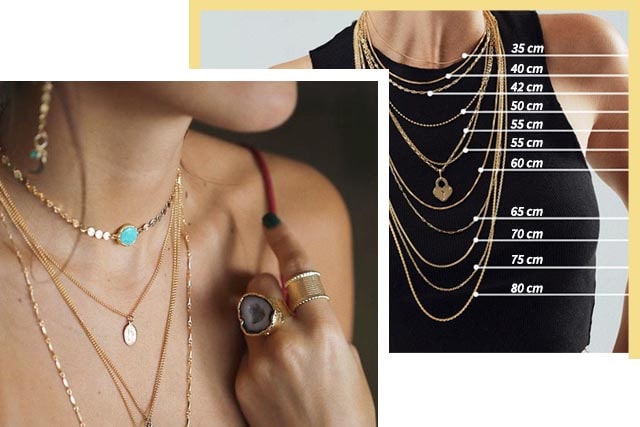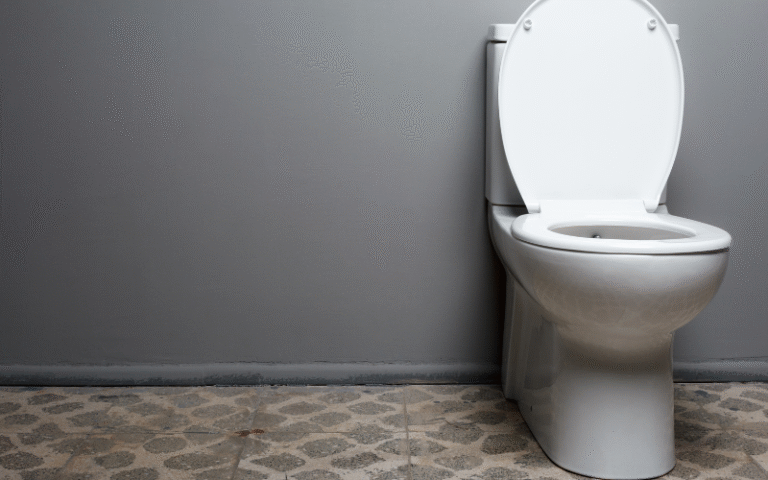How to Measure Necklace Length: Perfect Fit Guide
To measure necklace length, use a flexible measuring tape or string, then measure around the neck. When measuring, ensure a comfortable fit without being too tight or loose.
Next, lay the string flat and measure the length using a ruler. This will give you an accurate measurement for choosing the right necklace length that suits your style and preference. Understanding the correct necklace length for your body type and outfit is crucial for achieving the desired look.
Whether you prefer a choker, princess, matinee, opera, or rope length, knowing how to measure ensures your necklace complements your overall appearance. Let’s delve deeper into the importance of measuring necklace length accurately and how it impacts your fashion choices.
Introduction To Necklace Sizing
When it comes to accessorizing, a necklace can be the perfect finishing touch to any outfit. However, choosing the right necklace length is crucial to ensure a proper fit and enhance your overall look. In this guide, we will explore the importance of a proper fit and the common necklace lengths available, so you can confidently measure and select the perfect necklace for any occasion.
Importance Of Proper Fit
Choosing the right necklace length is essential for both comfort and style. A necklace that is too short can feel restrictive, while one that is too long may not showcase the pendant or design as intended. By understanding the different necklace lengths available, you can ensure that the necklace sits at the perfect position on your neckline, enhancing your features and complementing your outfit.
Common Necklace Lengths
There are several standard necklace lengths to choose from, each with its own unique style and purpose. Here are some of the most common necklace lengths and their characteristics:
| Necklace Length | Description |
|---|---|
| Choker | A choker necklace sits snugly around the base of the neck, typically measuring around 14 inches in length. This length is perfect for showcasing a delicate pendant or adding a touch of elegance to a high neckline. |
| Princess | The princess length necklace is one of the most versatile options, measuring around 18 inches. It falls just below the collarbone, making it suitable for both casual and formal occasions. |
| Matinee | A matinee necklace measures around 20-24 inches, falling between the collarbone and the bust. This length is ideal for adding a touch of sophistication to your attire. |
| Opera | Opera length necklaces typically measure around 28-36 inches, extending below the bust. This length is perfect for creating a dramatic and elegant look, as the necklace can be worn as a single strand or doubled up for a layered effect. |
| Rope | A rope necklace is the longest option, measuring over 36 inches. This length offers endless possibilities, allowing you to experiment with different styles such as knotting or layering. |
Now that you are familiar with the importance of a proper fit and the common necklace lengths available, you can confidently measure and select the perfect necklace to enhance your style. Remember to consider your personal preferences, the occasion, and the neckline of your outfit when choosing the right necklace length. With the right necklace, you can effortlessly elevate your look and make a statement wherever you go.

Credit: www.wikihow.com
Essential Tools For Measuring
When it comes to measuring necklace length, having the right tools is essential to ensure accuracy. Here are the essential tools for measuring necklace length:
Flexible Measuring Tape
A flexible measuring tape is a versatile tool that can be easily wrapped around the neck to determine the desired necklace length. It provides a precise measurement and is commonly used by jewelry makers and designers.
Ruler And String Method
The ruler and string method is a simple yet effective way to measure necklace length. It involves using a ruler and a piece of string to determine the desired necklace length. This method is convenient and can be easily done at home.
Anatomy Of A Necklace
Discovering the right necklace length is essential for a perfect fit. Measure the chain to ensure it complements your style effortlessly. Understanding the anatomy of a necklace helps in choosing the ideal length for any occasion.
Chain Types And Thickness
When it comes to measuring necklace length, understanding the anatomy of a necklace is crucial. One of the key elements to consider is the type and thickness of the chain. Chains come in various styles, each contributing to the overall look and feel of the necklace. Let’s take a closer look at the different chain types and thickness options:
| Chain Type | Description |
|---|---|
| Bead Chain | A chain made up of small beads that are linked together. |
| Box Chain | A chain made up of square-shaped links that fit together to form a smooth and sleek appearance. |
| Cable Chain | A simple chain made up of round or oval links, providing a classic and versatile look. |
| Rolo Chain | A chain consisting of round links that are usually thicker and more substantial in size. |
| Figaro Chain | A chain with a pattern of two or three small links followed by a larger link, creating a unique and eye-catching design. |
| Snake Chain | A chain with closely fitted, interlocking wavy links that give the appearance of a flexible tube. |
When determining the appropriate chain thickness, it’s important to consider personal preferences and the necklace’s intended purpose. A thinner chain creates a delicate and dainty look, ideal for small pendants or everyday wear. On the other hand, a thicker chain adds a bold and statement-making touch, perfect for larger pendants or special occasions.
Clasp Variations
Another aspect to consider when measuring necklace length is the type of clasp used. The clasp not only secures the necklace but also adds to its overall aesthetic appeal. Here are some common clasp variations:
- Spring Ring Clasp: A small, circular clasp that opens and closes by applying pressure.
- Lobster Clasp: A larger clasp with a spring-loaded mechanism and a tiny lever to open and close it.
- Toggle Clasp: Consists of a bar that fits through a ring, creating a secure and stylish closure.
- Magnetic Clasp: Contains magnets that attract and snap together, providing a convenient and easy-to-use closure.
- Box Clasp: A two-part clasp that locks together, often seen in vintage or high-end jewelry.
Choosing the right clasp depends on personal preference, ease of use, and the overall design of the necklace. It’s essential to ensure that the clasp is sturdy enough to hold the weight of the necklace and easy enough to open and close without assistance.
Standard Necklace Lengths
When it comes to choosing the perfect necklace, getting the right length is essential for both comfort and style. Whether you prefer a choker that sits snugly around your neck or a long rope necklace that adds drama to your ensemble, understanding the different standard necklace lengths is key. In this article, we will explore the various necklace lengths, including choker, princess, matinee, opera, and rope, and how they can enhance your look.
Choker
A choker necklace is designed to sit tightly around the neck, typically measuring around 14 to 16 inches in length. This style is perfect for adding a touch of elegance and sophistication to any outfit. Chokers can be worn alone as a statement piece or layered with longer necklaces for a trendy and fashionable look.
Princess
The princess necklace is the most common and versatile length, usually measuring around 18 inches. This necklace length falls just below the collarbone and is suitable for most necklines. The princess necklace is incredibly versatile and can be worn with casual or formal attire. It is a classic choice that offers a balance between elegance and simplicity.
Matinee
The matinee necklace is slightly longer, typically measuring between 20 and 24 inches. This length allows the necklace to fall just above the bust, making it an excellent choice for both high and low necklines. The matinee necklace adds a touch of sophistication and is often worn to create a more polished and refined look.
Opera
The opera necklace is a longer style that measures around 28 to 36 inches. This length allows the necklace to be worn as a single strand or doubled up for a layered effect. The opera necklace adds drama and elegance to any outfit, making it a popular choice for formal occasions or when you want to make a statement.
Rope
The rope necklace is the longest of all the standard lengths, typically measuring 40 inches or more. This versatile necklace can be worn in various ways, such as a single long strand, doubled up, or even wrapped multiple times around the neck. The rope necklace adds a touch of glamour and is perfect for creating a bold and eye-catching look.
Step-by-step Measuring Process
When it comes to buying a necklace, getting the right length is essential for both comfort and style. Here’s a step-by-step guide to help you measure the necklace length accurately.
Prepare Your Tools
To measure necklace length accurately, you will need:
- A flexible tape measure or a piece of string
- A ruler or a straight measuring tape
- A mirror or someone to assist you
Measure An Existing Necklace
If you already have a necklace that fits well, you can use it as a reference:
- Lay the necklace straight on a flat surface
- Measure the length from end to end using a ruler or tape measure
- Take note of the measurement in inches or centimeters
Measure Your Neck
When measuring your neck for a necklace, follow these steps:
- Wrap a flexible tape measure around your neck at the desired position
- Make sure it’s not too tight or too loose, leaving a bit of space for comfort
- Note down the measurement in inches or centimeters

Credit: www.bryananthonys.com
Customizing Necklace Length
Considering Body Type
When choosing the length of a necklace, it’s essential to consider the wearer’s body type. For instance, shorter necklaces work well for petite individuals, while longer necklaces complement taller figures. By taking body proportions into account, you can ensure the necklace enhances the overall appearance.
Accounting For Pendant Size
The length of a necklace should be adjusted based on the size of the pendant. For instance, longer necklaces are ideal for showcasing larger pendants, while shorter chains accentuate smaller ones. By pairing the right pendant size with the appropriate necklace length, you can create a harmonious and balanced look.
Layering Necklaces
Layering necklaces involves combining multiple chains of varying lengths to create a stylish and personalized look. For example, layering a choker with a longer pendant necklace adds depth and visual interest to an outfit. By experimenting with different necklace lengths, you can achieve a unique and fashionable layered effect.
Tips For Online Necklace Shopping
Understanding Sizing Charts
Refer to the sizing chart for accurate measurements.
Communicating With Sellers
Ask sellers for additional details when unsure about length.
Caring For Your Necklaces
To measure necklace length accurately, use a flexible tape measure or string. Start from the base of the neck, down to the desired length. Ensure a comfortable fit by adjusting the measuring tool before choosing your perfect necklace.
Proper Storage
Store necklaces separately to avoid tangling.
Use a jewelry box with compartments for each necklace.
Cleaning And Maintenance
Clean with a soft cloth after each wear.
Use a jewelry cleaner for deep cleaning.
Avoid exposing necklaces to harsh chemicals.

Credit: www.alexmakina.com
Frequently Asked Questions
How Do I Measure Necklace Length?
To measure necklace length, use a measuring tape or a string to determine the desired length. Wrap the measuring tape around your neck or use the string to measure the desired length. Add an extra inch or two for comfort.
What Is The Standard Necklace Length?
The standard necklace length for women is 18 inches, while men’s necklaces are typically 20-24 inches long. However, necklace lengths can vary depending on personal style and the type of necklace.
How Do I Choose The Right Necklace Length?
When choosing a necklace length, consider the neckline of the outfit you will be wearing. A shorter necklace pairs well with a high neckline, while a longer necklace complements a lower neckline. Personal preference and body type should also be taken into account.
Conclusion
To conclude, measuring necklace length may seem like a daunting task, but it doesn’t have to be. By following these simple steps, anyone can accurately measure their necklace length and ensure that it fits perfectly. Remember to measure from end to end, account for the clasp, and consider the style and occasion.
With these tips in mind, you’ll be able to confidently wear your necklace and showcase it in the best way possible.







